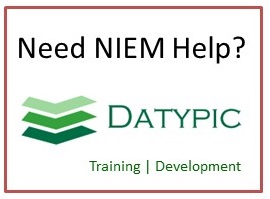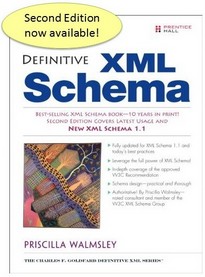geo:LocationGeometry
A GML geometry that describes a location.
Element information
Namespace: http://release.niem.gov/niem/adapters/geospatial/3.0/
Schema document: adapters/geospatial/3.0/geospatial.xsd
Type: geo:GeometryType
Properties: Global, Qualified, Nillable
Content
- Sequence [1..1]
- structures:ObjectAugmentationPointAbstract [0..*]An augmentation point for ObjectType
- Choice [1..1]
- gml:MultiGeometrygml:MultiGeometry is a collection of one or more GML geometry objects of arbitrary type. The members of the geometric aggregate may be specified either using the "standard" property (gml:geometryMember) or the array property (gml:geometryMembers). It is also valid to use both the "standard" and the array properties in the same collection.
- gml:MultiPointA gml:MultiPoint consists of one or more gml:Points. The members of the geometric aggregate may be specified either using the "standard" property (gml:pointMember) or the array property (gml:pointMembers). It is also valid to use both the "standard" and the array properties in the same collection.
- gml:MultiCurveA gml:MultiCurve is defined by one or more gml:AbstractCurves. The members of the geometric aggregate may be specified either using the "standard" property (gml:curveMember) or the array property (gml:curveMembers). It is also valid to use both the "standard" and the array properties in the same collection.
- gml:MultiSurfaceA gml:MultiSurface is defined by one or more gml:AbstractSurfaces. The members of the geometric aggregate may be specified either using the "standard" property (gml:surfaceMember) or the array property (gml:surfaceMembers). It is also valid to use both the "standard" and the array properties in the same collection.
- gml:MultiSolidA gml:MultiSolid is defined by one or more gml:AbstractSolids. The members of the geometric aggregate may be specified either using the "standard" property (gml:solidMember) or the array property (gml:solidMembers). It is also valid to use both the "standard" and the array properties in the same collection.
- gml:PointA Point is defined by a single coordinate tuple. The direct position of a point is specified by the pos element which is of type DirectPositionType.
- gml:LineStringA LineString is a special curve that consists of a single segment with linear interpolation. It is defined by two or more coordinate tuples, with linear interpolation between them. The number of direct positions in the list shall be at least two.
- gml:CompositeCurveA gml:CompositeCurve is represented by a sequence of (orientable) curves such that each curve in the sequence terminates at the start point of the subsequent curve in the list. curveMember references or contains inline one curve in the composite curve. The curves are contiguous, the collection of curves is ordered. Therefore, if provided, the aggregationType attribute shall have the value "sequence".
- gml:CurveA curve is a 1-dimensional primitive. Curves are continuous, connected, and have a measurable length in terms of the coordinate system. A curve is composed of one or more curve segments. Each curve segment within a curve may be defined using a different interpolation method. The curve segments are connected to one another, with the end point of each segment except the last being the start point of the next segment in the segment list. The orientation of the curve is positive. The element segments encapsulates the segments of the curve.
- gml:OrientableCurveOrientableCurve consists of a curve and an orientation. If the orientation is "+", then the OrientableCurve is identical to the baseCurve. If the orientation is "-", then the OrientableCurve is related to another AbstractCurve with a parameterization that reverses the sense of the curve traversal.
- gml:PolygonA Polygon is a special surface that is defined by a single surface patch (see D.3.6). The boundary of this patch is coplanar and the polygon uses planar interpolation in its interior. The elements exterior and interior describe the surface boundary of the polygon.
- gml:CompositeSurfaceA gml:CompositeSurface is represented by a set of orientable surfaces. It is geometry type with all the geometric properties of a (primitive) surface. Essentially, a composite surface is a collection of surfaces that join in pairs on common boundary curves and which, when considered as a whole, form a single surface. surfaceMember references or contains inline one surface in the composite surface. The surfaces are contiguous.
- gml:SurfaceA Surface is a 2-dimensional primitive and is composed of one or more surface patches as specified in ISO 19107:2003, 6.3.17.1. The surface patches are connected to one another. patches encapsulates the patches of the surface.
- gml:PolyhedralSurfaceA polyhedral surface is a surface composed of polygon patches connected along their common boundary curves. This differs from the surface type only in the restriction on the types of surface patches acceptable. polygonPatches encapsulates the polygon patches of the polyhedral surface.
- gml:TriangulatedSurfaceA triangulated surface is a polyhedral surface that is composed only of triangles. There is no restriction on how the triangulation is derived. trianglePatches encapsulates the triangles of the triangulated surface.
- gml:TinA tin is a triangulated surface that uses the Delauny algorithm or a similar algorithm complemented with consideration of stoplines (stopLines), breaklines (breakLines), and maximum length of triangle sides (maxLength). controlPoint shall contain a set of the positions (three or more) used as posts for this TIN (corners of the triangles in the TIN). See ISO 19107:2003, 6.4.39 for details.
- gml:OrientableSurfaceOrientableSurface consists of a surface and an orientation. If the orientation is "+", then the OrientableSurface is identical to the baseSurface. If the orientation is "-", then the OrientableSurface is a reference to a gml:AbstractSurface with an up-normal that reverses the direction for this OrientableSurface, the sense of "the top of the surface".
- gml:CompositeSolidgml:CompositeSolid implements ISO 19107 GM_CompositeSolid (see ISO 19107:2003, 6.6.7) as specified in D.2.3.6. A gml:CompositeSolid is represented by a set of orientable surfaces. It is a geometry type with all the geometric properties of a (primitive) solid. Essentially, a composite solid is a collection of solids that join in pairs on common boundary surfaces and which, when considered as a whole, form a single solid. solidMember references or contains one solid in the composite solid. The solids are contiguous.
- gml:SolidA solid is the basis for 3-dimensional geometry. The extent of a solid is defined by the boundary surfaces as specified in ISO 19107:2003, 6.3.18. exterior specifies the outer boundary, interior the inner boundary of the solid.
- gml:GeometricComplex
- gml:GridThe gml:Grid implicitly defines an unrectified grid, which is a network composed of two or more sets of curves in which the members of each set intersect the members of the other sets in an algorithmic way. The region of interest within the grid is given in terms of its gml:limits, being the grid coordinates of diagonally opposed corners of a rectangular region. gml:axisLabels is provided with a list of labels of the axes of the grid (gml:axisName has been deprecated). gml:dimension specifies the dimension of the grid. The gml:limits element contains a single gml:GridEnvelope. The gml:low and gml:high property elements of the envelope are each integerLists, which are coordinate tuples, the coordinates being measured as offsets from the origin of the grid along each axis, of the diagonally opposing corners of a "rectangular" region of interest.
- gml:RectifiedGridA rectified grid is a grid for which there is an affine transformation between the grid coordinates and the coordinates of an external coordinate reference system. It is defined by specifying the position (in some geometric space) of the grid "origin" and of the vectors that specify the post locations. Note that the grid limits (post indexes) and axis name properties are inherited from gml:GridType and that gml:RectifiedGrid adds a gml:origin property (contains or references a gml:Point) and a set of gml:offsetVector properties.
from subst. group gml:AbstractGeometryfrom subst. group gml:AbstractGeometricAggregatefrom subst. group gml:AbstractGeometricPrimitivefrom subst. group gml:AbstractCurvefrom subst. group gml:AbstractSurfacefrom subst. group gml:Surfacefrom subst. group gml:TriangulatedSurfacefrom subst. group gml:AbstractSolidfrom subst. group gml:AbstractImplicitGeometryfrom subst. group gml:Grid
from type structures:ObjectTypefrom subst. group structures:ObjectAugmentationPoint
Attributes
| Name | Occ | Type | Description | Notes |
|---|---|---|---|---|
| structures:id | [0..1] | xsd:ID | from type structures:ObjectType | |
| structures:ref | [0..1] | xsd:IDREF | from type structures:ObjectType | |
| structures:metadata | [0..1] | xsd:IDREFS | from type structures:ObjectType | |
| structures:relationshipMetadata | [0..1] | xsd:IDREFS | from type structures:ObjectType | |
| Any attribute | [0..*] | Namespace: urn:us:gov:ic:ism urn:us:gov:ic:ntk, Process Contents: lax | from type structures:ObjectType |
Used in
- Type biom:CaptureLocationType via extension of nc:LocationType (Element biom:CaptureLocation)
- Type em:AlertAffectedLocationType via extension of nc:LocationType (Element em:AlertAffectedLocation)
- Type em:NotificationTargetLocationType via extension of nc:LocationType (Element em:NotificationTargetLocation)
- Type it:GoodsLocationType via extension of nc:LocationType (Element it:GoodsLocationText)
- Type it:GoodsOriginType via extension of nc:LocationType (Element it:CountryOfOrigin)
- Type it:LoadingLocationType via extension of nc:LocationType (Element it:LoadingLocation)
- Type it:TranshipmentLocationType via extension of nc:LocationType (Element it:TranshipmentLocation)
- Type it:UnloadingLocationType via extension of nc:LocationType (Element it:UnloadingLocation)
- Type nc:LocationType (Elements cyfs:AdoptionLocation, cyfs:PlacementOtherLocation, em:AlarmEventLocation, em:AlarmLocation, em:ArrivalLocation, em:ResourceCurrentLocation, em:ResourceDepartureLocation ...more)
Substitution hierarchy
- nc:LocationAugmentationPoint
- can be substituted with geo:LocationGeometry
Sample instance
<geo:LocationGeometry> <structures:ObjectAugmentationPoint>any content</structures:ObjectAugmentationPoint> <gml:MultiGeometry gml:id="ID"> <gml:metaDataProperty> <gml:GenericMetaData>Any text, intermingled with: <!--any element--> </gml:GenericMetaData> </gml:metaDataProperty> <gml:description>string</gml:description> <gml:descriptionReference/> <gml:identifier codeSpace="http://www.example.com/">string</gml:identifier> <gml:name>string</gml:name> <gml:geometryMember> <gml:MultiGeometry gml:id="ID">... </gml:MultiGeometry> </gml:geometryMember> <gml:geometryMembers> <gml:MultiGeometry gml:id="ID">... </gml:MultiGeometry> </gml:geometryMembers> </gml:MultiGeometry> </geo:LocationGeometry>



